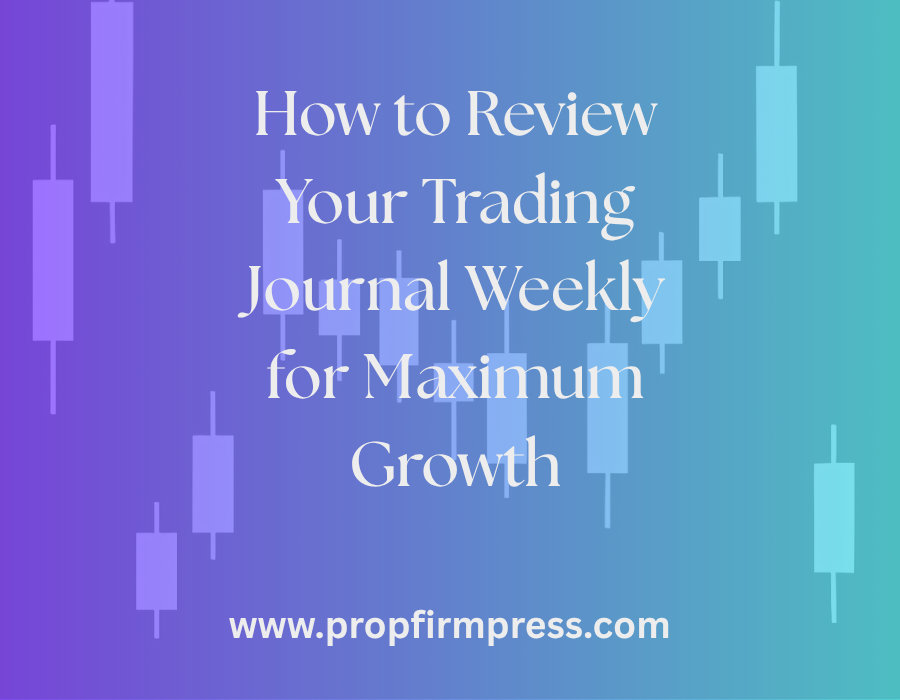How to Review Your Trading Journal Weekly for Maximum Growth
Journaling after each trading session is valuable—but it’s the weekly review that ties everything together. A well-structured end-of-week review allows you to reflect on patterns, correct mistakes, and strengthen habits before they spiral. If you’re aiming to pass a prop firm challenge or maintain a funded account, your weekly journal review is your roadmap to real growth.
Why Weekly Review Beats Daily Notes Alone
Daily journaling captures snapshots of performance and emotion. But weekly reviews reveal trends. You may not notice that you always overtrade on Fridays until you zoom out. Likewise, you might discover that your morning trades are consistently better than your afternoon ones. These insights only emerge when you analyze multiple days together.
Set a Fixed Review Day
The first step to successful weekly review is consistency. Pick one day—usually Friday after the market closes or Sunday before the new week—and block off 30–60 minutes. Treat it like a meeting with your future self. This habit is what turns random data into structured improvement.
Use a Standard Review Template
Instead of reinventing your process every week, use a reliable structure. The Prop Firm Press Journal Sheets include a Weekly Review page that prompts you with:
- Number of trades taken
- Win rate, risk-to-reward, and drawdown
- Top 3 mistakes and top 3 wins
- Strategy compliance score (Did I follow my rules?)
- Emotional stability rating (1–5 scale)
This gives you both numerical and behavioral feedback to work from.
Identify What Worked
Go back through your journal entries and ask:
- Which setups had the best results?
- Did you perform better at a certain time of day?
- Were there trades where you executed flawlessly—even if it lost?
Don’t just celebrate wins—understand why they worked. You want to reinforce those behaviors in future weeks.
Spot Recurring Mistakes
Mistakes don’t always look dramatic. Sometimes it’s sizing too aggressively. Sometimes it’s entering early or late. Your weekly review should flag any:
- Rule violations
- Impatience or revenge trading
- Trades taken outside your edge
Make a list of these errors and quantify them. How many trades did you take impulsively? How many were outside your plan? This gives you a baseline to improve from.
Evaluate Rule Adherence
Prop firms like Prop Shop Traders or Instant Funding will fail you for breaking rules even if you’re profitable. So your journal review should ask: How well did I respect my risk, trading hours, max loss, and trade count?
If you’re consistently breaking internal or firm rules, you’re not yet trading like a professional—even if you’re green.
Track Metrics That Matter
Each week, update your rolling statistics:
- Weekly PnL (win/loss total)
- Number of trades
- Win rate
- Average risk-to-reward
- Drawdown size
Seeing these metrics in one place helps you catch declines early—and gives you a performance history over time.
Set Weekly Improvement Goals
After identifying patterns and metrics, commit to just one or two improvements for the next week. For example:
- “No more than 2 trades per session”
- “Review setups for 10 minutes before placing a trade”
- “Take screenshots for every trade”
Don’t try to fix everything at once. Focus on the habits that create the most change.
Review Your Journal Like a Fund Manager
If you were managing someone else’s capital, how would you grade your weekly performance? Would you invest in yourself? This lens helps traders remove emotion and get honest about improvement areas.
The Power of Compounding Reviews
One review won’t change everything. But 52 of them will. If you do a detailed weekly review every week for a year, your trading behavior will shift dramatically. Most traders try to improve by switching strategies. Smart traders improve by reviewing the one they already have—until it works with discipline and control.
